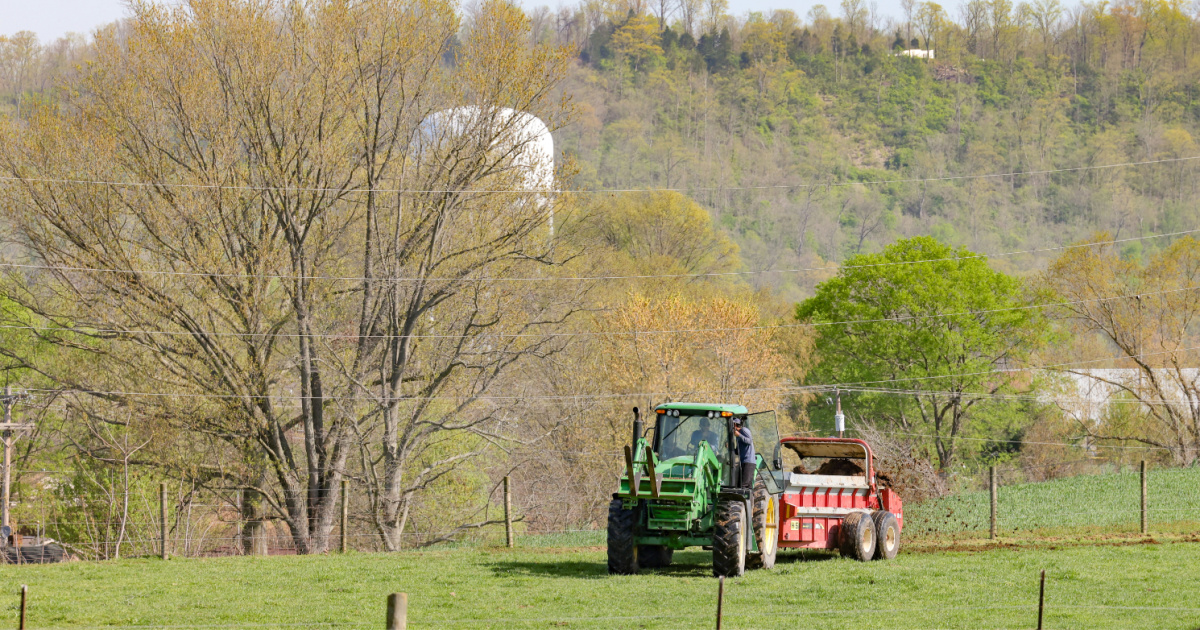Conservation on the Farm
Posted on Apr 30, 2024Farm families continue to do their part to care for their natural resources.
Zac and Taylor Jones are first-generation farmers producing a variety of crops to make their Gallatin County farm successful. From a direct-to-market produce business to row crops, burley tobacco, cattle, and hemp, they cover a lot of ground on their 1,000 acres of owned/leased farmland, both figuratively, and from a production perspective.
"We're not really big with anything but we do a lot of different things on the farm from a production standpoint from the traditional crops like tobacco, corn, and soybeans to our produce crops, tomatoes being the largest of those, to our hemp," Taylor said. "We also have a cow-calf operation and a home delivery service for our produce."
The brothers have found that diversification is one of the keys to profitability. However, it is their care of the natural resources that makes their crop and animal operations more sustainable and ultimately leads to more profitability.
Some of their many conservation measures include the use of cover crops and drip irrigation, no-till planting, and rotational grazing for their cattle.
“About 80 to 90 percent of our tobacco and hemp is no-till and 90 to 100 percent of our corn and soybeans is also no-till,” Zac said. “We also use drip irrigation for our crops whether outside or in our greenhouses.”
The use of drip irrigation not only allows for more efficient use of water resources, but their system also allows the same efficiency with chemicals or fertilizers.
"We want to give that plant exactly what it needs when it needs it," Taylor said. "Whether you're looking at it from a sustainability perspective or a profitability perspective, we don't want to put more out there than the plant can use. That could create runoff, and if it makes its way into the water streams, we would have just paid to pollute the water and that just doesn't make sense, any way you look at it."
The Jones brothers have been growing corn and soybeans on the farm since 2020 and have always used the no-till method of planting for those crops. In doing so, they found the same method could be used in all their crops along with a systematic rotation. But all their efforts aren’t’ necessarily overnight successes.
“We're looking at things all the time from a three, five, and 10-year perspective, which is a lot more difficult than looking at it from a one-year perspective,” Zac said. “And every single acre may not be the most profitable this year, but we think the way we're doing it kind of gives us the best five to 10-year picture with the healthiest soil going into year six or 11.”
It is safe to say that most farm families in Kentucky are using similar practices in their operations and have for decades.
Brad Hines of Magnolia Kentucky farms about 3,000 acres of owned and rented land in Hart, LaRue, and Green Counties following conservation efforts passed down by his father and grandfather.
“Everything we grow on the farm is no-till planted,” he said. “We have corn, wheat, soybeans, and alfalfa hay. We also have a fall-calving cow herd. The no-till production probably started with my grandpa and my dad and we have been completely no-till for about 10 years.”
Hines said that practicing no-till production along with a conventional crop rotation makes the soil healthier. He also uses some of the wheat crop to graze his cattle.
"We're actually grazing some wheat now and that helps our pastures to get healthier, too," he said. Some of our wheat that we spread over top of soybeans as a cover crop, may not be thick enough to make grain, but it can give other pastures a break."
Hines sees his conservation efforts as vital to the success and future of the farm.
“It's very important that we keep the land and leave it better shaped than when we started,” he said. “There are several farms that I've been able to get where we've had to work on the waterways and a lot of ground that hadn’t been planted. We’ve been able to keep something growing on this land which makes for healthier soil.”
Hines said he has also made adjustments to equipment to make planting more efficient, something that cuts costs and ultimately helps yields.
Alfalfa has become an important crop on the farm where tobacco was grown for many years.
“I grew 25 crops of burley tobacco on my own starting when I was 14 and this is going to be my third year without tobacco,” he said. “We started adding alfalfa about 10 years ago and it's just kind of a specialty crop. And now that we've accumulated enough customers, we're putting it about everywhere we can.”
As with any crop, weed control is important and Hines pointed out that the use of cover crops can lessen weed pressure. In fact, there have been multiple studies at universities across the country that have studied the efforts of cover crop usage and weed control management.
“It definitely helps and in the fields we plant, if we miss some places where it could have been wet or some reason that kept us from seeding that area, those spots will have weed pressure all year long,” he said.
Farmers like the Jones Brothers and Hines constantly explore new ways to be efficient from a production standpoint as well as being conservation-minded. From rotational grazing with their cattle to water usage management to no-till production, they are indicative of the farm families across the state who have made care for the environment part of their plans to remain sustainable and profitable.

Comments